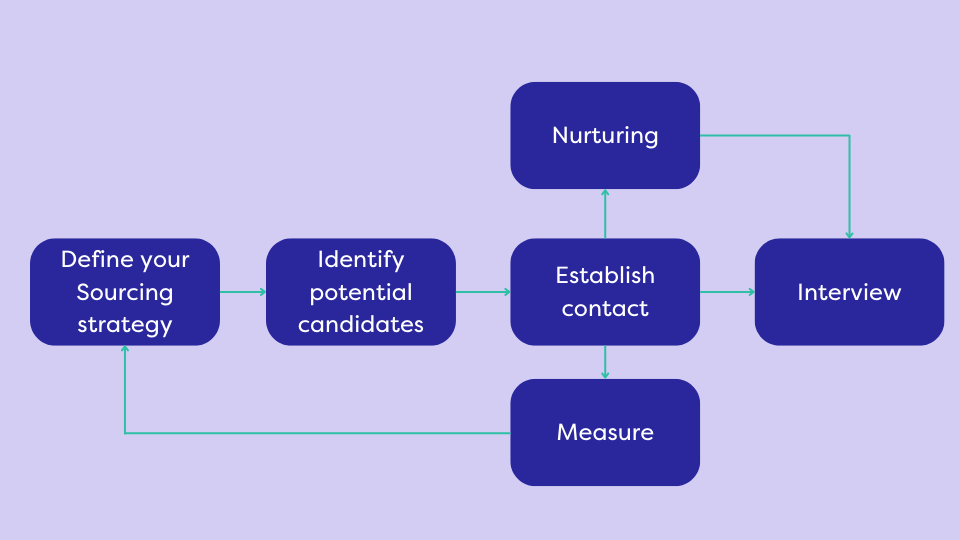The Talent Acquisition Process, is a multi-step approach to identifying, attracting, and hiring the best talent for your organization. It involves a number of steps including sourcing strategies, searching for candidates, reaching out to potential candidates and measuring performance.
Having an efficient Talent Acquisition Process is critical to make great hire : the right person, the right place and the right time.
If you don't have all three, it's going to be difficult to build a talented team. In order for your company to attract and retain talent, we have established a framework to help you build a great hiring machine.

Defining your sourcing strategy
A great TA team has a deep understanding of what makes its company successful and uses this knowledge when creating strategies that are tailored towards attracting, hiring and retaining top performers—those who can help drive the organization forward in its mission-critical roles. The right TA professionals know how to build relationships with internal stakeholders so that they're viewed as partners rather than just vendors—and they use their expertise as a means of helping develop valuable career paths within the organization at large.
The TAP begins with a sourcing strategy. This is how you decide who will be your potential candidates for your open positions and how you go about finding them. Your first step should be determining the type of person you want to hire for this position—whether it’s someone with great communication skills or someone who can solve complex problems using data science tools like Python or R.
Once you have defined your Ideal Candidate Personas, the key is to establish various approaches to find it. Sourcing is an art and science in equal measure. It requires a good understanding of the job requirements and accuracy in translating those into queries that are capable of finding the right people. Sourcing also includes evaluating how results are relevant, iteratively refining your search strings, and intel gained from each successive search.
Here are a few exemples on how to find Java Developers on Linkedin
- The basic Approach : searching for profiles containing the Java keyword
- Looking for indirect keywords such as "J2EE" or "J EE" or "J EE5" which are always associated with Java language
- Looking for developers working in companies that use Java technology : Uber, Linkedin, PayPal...
- Looking groups or events dedicated to the Java ecosystem
- ....
How do you make your process more effective ?
By saving and sharing all the strategies you used in the past. By measuring what worked more and what worked less. You will build your strategy librairie that you will improve over time.
Search and identify potential candidates
Now that you defined how you want to approach your search, you have to translate it into actual search queries. Linkedin is often the bestplace to start searching since it has the most complete database of profiles.
Finding the right search queries is an iterative process where you'll need to extend and narrow down your search until you find the right scope.
Here the main boolean search operators that you need to know in the process :
AND Search Operator
The AND operator is inclusionary and thus limits your search.
It should be used for targeting required skills, experience, technologies, or titles you would like to limit your results to. Unless you are searching for common words, with every AND you add to your Boolean query, the fewer results you will typically get.
Example: Java AND SQL
OR Search Operator
The OR operator offers flexible inclusion, and typically broadens your search results.
Example: Java OR "J2EE"
NOT Search Operator
The NOT (often used as '-') operator is exclusionary, it excludes specific search terms and so the query will not return any results with that term (or terms) in them.
Exemple : Developer AND -business
Parenthesis search operator
As a best practice, use parentheses to encapsulate OR statements for the search engines to execute them properly.
Exemple : ("Head of" OR director OR VP OR chief) AND (marketing OR acquisition OR brand)
How do you make your process more efficient ?
Again, you need to build your library of the best queries you built in association with the strategies you defined. Do not reinvent the wheel every time you start a new search. Your hiring team should be able to capitalize on knowledge you gained over time.
Tools like Leonar can help you searching using pre-built filters and scoring algorithm. You can also create and save your own queries.
Reaching out to potential candidates
Having selected the most promising talents for your job opening is great, but you now need to establish contact with them. The question here is : how do I get higher response rate to my outreach campaigns ? Here is the list of things you must do in order to get at least 50% response rate for all your campaigns.
Better targeting
What people hate the most is not being contacted too often or not getting a personalized message. What they really hate is being contacted for a role that has nothing to do with their current skills or career path. The best thing you can do to increase your response rate is to make sure you contact people for roles that are relevant to them.
Personalization
It's not a secret, if you take the time to add a personal note to every candidate, you will stand out from the crowd of robotic recruiters, and you will definitely get more responses. One way to do so while not taking too much time and keep using automation is to contact small batches of profiles. You could create various segments of candidates with a dedicated message sequence (ex : batch of profiles having same current team size, same industry, same tools used...)
Send connection requests instead of inMails
If you contact profiles on Linkedin, you need to know that inMails often get much lower response rates than connection requests. Inmails are often used in batch by recruiters or sales people and it is often perceived as colder than connection requests. Tools like Leonar can help you connect quickly with semi-automated workflows.
Send Follow ups
Have you tried to send followups after a few days ? Then have you tried to send 2 followups ? It's amazing how many more replies you will get. We have measured that your response rate will double if you follow up twice after sending a first message. So please, follow-up on your talents if you didn't get any reply.
Use multiple channels
To maximize your chances that your message will reach someone, it's better to test multiple channels. Some people do not go on Linkedin often, or they might have missed your connection request. Following up by inMails or Email will most certainly boost your response rate.
Talent Nurturing
Do not forget, a great recruitment is finding the right person, at the right place at the right time.
As a recruiter, the most difficult part is certainly being here at the right time for a candidate, the moment when he is starting to look for new opportunities. On average, only about 10-20% of potential candidates you will contact will be open to new opportunities at the time you contacted them. In order to leverage your amazing network that you built over time, you need to build long term relationships with them.
Every time we establish contact with a potential candidate, we add him/her into a Talent Pool. For profiles that are not open to new opportunities, we add a snooze of 4-6 months.
By following this process, you will soon build a list of amazing profiles that you know are relevant for your company and can reach out to quickly.
For exemple, every time we are looking for a Product Manager, we start by reaching out to the profiles that we have not contacted for a while. This way, we always get 2 or 3 amazing profiles in the process. It's also a great way to stay top of mind for most of them :)
This technique of building long term relationships is often called Talent Pipelining.
Conclusion
We’re living in an interesting time. The world is changing and so are our businesses. Finding the right people for your team can be a challenging task, but it doesn’t have to be impossible. If you build a talent acquisition machine that focuses on great people, hiring processes, and systems, you’ll be able to find the candidates who will help your company succeed.


.svg)



